- HOME
- ABOUT US
- SOLUTIONS
- Metal Roof PV Mounts and Systems
- Flat Roof Solar Panel Mounting Systems Solutions
- Tile Roof Solar Mounting Systems Solutions
- Solar Tracking Solutions for Commercial PV Projects
- Ground Solar Mounting Systems Solutions
- Floating Solar Solutions - PV Systems
- PV Solar Carport Mounting Systems Solutions
- Balcony Solar Panel Mounting Systems Solutions
- PRODUCTS
- PROJECTS
- COMPANY NEWS
- BLOG
- Contact Us
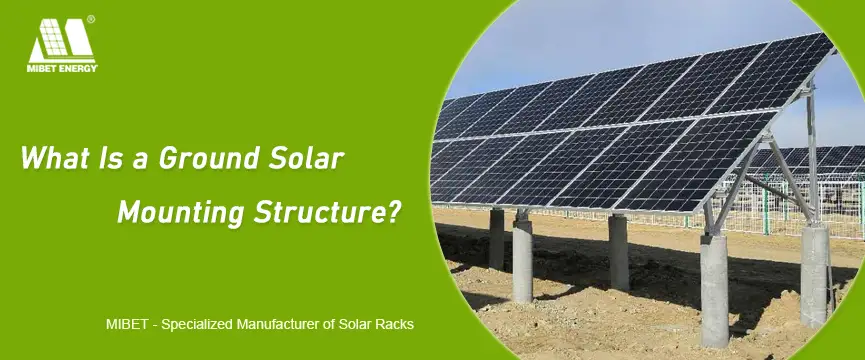
When considering solar energy, rooftop panels often come to mind. If your roof is not suited for solar panels but you have ample land, consider a ground solar mounting structure as a viable solution to meet your energy needs. In this article, we will explain what a ground-mounted solar system is and assist you in determining whether it is the right choice for your property.
Ground Solar Panel Mounting Structure
A ground solar mounting structure is a framework that supports solar panels installed on the ground. Unlike rooftop solar systems, these structures are built directly into the ground using steel beams, aluminum beams, or other types of metal posts. Ground mounts can be installed in open areas or on carports in parking lots.
Ground solar mounting structures are ideal for large-scale solar projects, such as solar farms, as they can cover expansive areas and are not limited by the structural constraints of a building. They also allow for easier maintenance and upgrading of solar panels compared to rooftop installations.
Key Components of Ground-Mounted Systems
Foundation
● Concrete Ballast: This is a common and cost-effective option for ground-mounted systems. Pre-cast concrete blocks are reasonably placed to provide stability. Considerations include soil type and wind loads to determine the size and placement of the blocks.
● Ground Screws: These are steel anchors screwed directly into the ground, offering a quicker and less invasive installation compared to concrete. They are ideal for areas with challenging soil conditions or where excavation is restricted.
● Driven Piles: Used in large-scale projects or areas with unstable soil, these are steel or concrete columns driven deep into the ground for maximum stability.
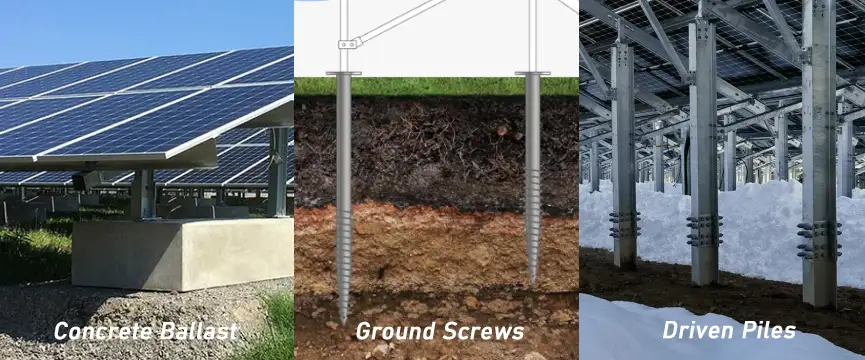
Support Structure
● Fixed-Tilt Structures: Offer a simple and economical design where the tilt angle is fixed during installation. The angle is determined based on the latitude and desired energy output.
● Single-Axis Trackers: These structures allow the panels to rotate on a single axis, following the sun's path from east to west throughout the day, resulting in increased energy production compared to fixed-tilt systems.
● Dual-Axis Trackers: Offering the highest energy output potential, these structures track the sun on both the east-west and north-south axes, ensuring optimal sunlight capture throughout the year.
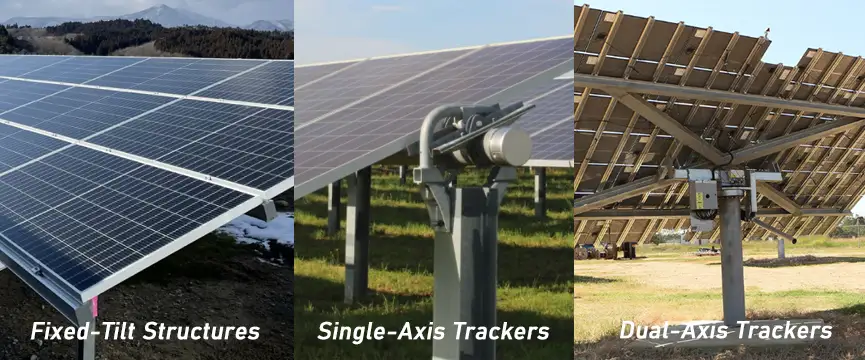
Mounting Rails
Aluminum rails are lightweight and corrosion-resistant, while galvanized steel offers higher strength but may be susceptible to rust in certain environments. Various rail profiles are available, each providing advantages depending on the panel type and wind load requirements.
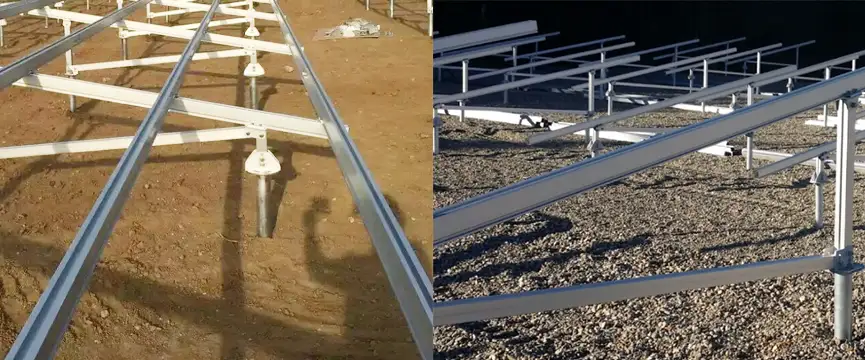
Module Clamps
End clamps secure the edges of the panels, while mid clamps secure the panels in between. The number and type of clamps used depend on the panel size and wind load. Clamps are typically made of aluminum or stainless steel for durability and corrosion resistance, with different designs offering varying levels of adjustability for optimizing panel angle.
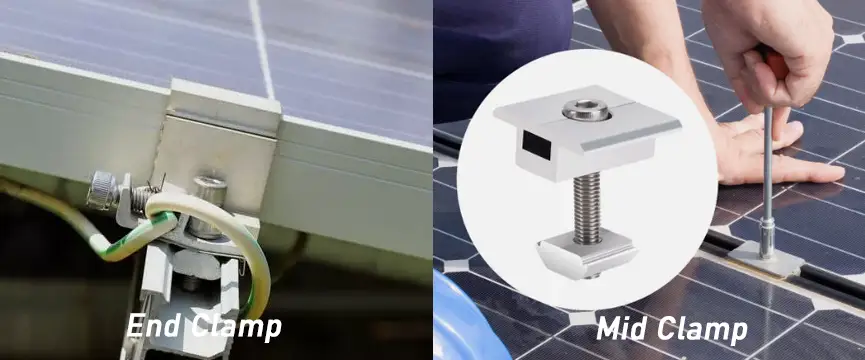
Types of Ground-Mounted Structures
Ground-mounted solar systems offer a variety of structural options to optimize energy production based on geographic location, budget, and energy needs.
Fixed-Tilt Systems
Fixed-tilt systems are characterized by their simplicity and cost-effectiveness. These systems are installed with a set tilt angle that is determined based on the latitude of the location to maximize solar irradiance throughout the year. They require minimal maintenance and have fewer mechanical parts, which reduces the likelihood of operational failures. Fixed-tilt systems are ideal for locations with consistent solar exposure and are commonly used in both residential and commercial solar installations.
Single-Axis Tracking Systems
Single-axis tracking systems are more advanced than fixed-tilt systems and can increase energy production by following the sun's path from east to west during the day. This tracking maximizes the solar panels' exposure to sunlight, enhancing energy output by up to 25% compared to fixed-tilt systems. These systems typically use a horizontal axis that is either north-south oriented or tilted at an angle optimized to the site’s latitude. Single-axis trackers are well-suited for regions with significant sunlight and are commonly used in large-scale commercial and utility projects. They strike a balance between increased energy yield and system complexity.
Dual-Axis Tracking Systems
Dual-axis tracking systems provide the highest potential energy output by tracking the sun’s movement across both the east-west and north-south axes. This allows the panels to maintain optimal alignment with the sun, capturing maximum solar energy throughout the day and across different seasons. Dual-axis systems can boost energy production by up to 40% more than fixed-tilt systems. However, they are the most complex and costly of the solar tracking solutions, involving more moving parts and requiring more maintenance. These systems are particularly effective in geographic locations with very high solar potential and varying seasonal sun paths, making them ideal for specialized applications where maximum efficiency is critical.
For a more comprehensive introduction to solar installation structures, please read this blog post: www.mbtenergy.com/different-types-of-solar-mounting-structures
Benefits of Ground Solar Mounting Structures
When considering solar panel installations, rooftop placement often presents the most straightforward and economical choice. However, if your home's roof is unsuitable, ground-mounted systems become a viable alternative with distinct advantages.
1. Optimal Solar Panel Orientation and Tilt
The biggest advantage with ground-mounted solar panels is that they offer greater control over your solar panel direction and angle. Solar panels need to face either south or southwest to receive maximum direct sunlight. On flat ground, you can position solar panels in any direction you want to maximize sun exposure, unlike on a slanted roof. This advantage means ground panels often receive more sunlight, allowing them to generate more solar power, thus saving you more money.
2. Easier to Expand
Ground-mounted systems are inherently scalable. They can start from a small scale and expand to a much larger facility as needs grow or budget permits. This flexibility is particularly advantageous for commercial power generation where future expansion might be anticipated, allowing for increased solar power generation by simply adding more solar panels.
3. Ease of Installation and Maintenance
Without the constraints and complexities of roof mounting, ground-mounted systems are typically easier and faster to install. They are also more accessible for routine maintenance, cleaning, and repairs, which helps maintain high efficiency and prolongs the system’s operational life. This accessibility reduces labor costs and the risk associated with working on rooftops.
4. Reduced Structural Risk
Installing solar panels on the ground avoids the potential structural risks associated with rooftop installations, such as leaks or added stress on the building’s roof. This aspect is particularly important for older buildings or structures not initially designed to support additional weight.
5. Utilization of Unproductive Land
Ground solar can transform low-value land into productive energy-generating areas. They are ideal for deploying on barren, contaminated, or unused lands where other development options are not feasible. This can lead to the revitalization of unused industrial sites, such as landfills or brownfields.
6. Dual Use (Agrivoltaics)
Installing solar PV power stations on agricultural land promotes the dual use of the land. This is integrating photovoltaics with crop production, where panels provide shade to crops, reduce water usage, and in some cases, increase yields, while still generating electricity.
Considerations When Choosing a Ground Mount
● Land availability and topography: The size and shape of the land influence the system's design and layout.
● Soil conditions: Determine the appropriate foundation type for stability.
● Wind and snow loads: The structure must be engineered to withstand local weather conditions.
● Budget and desired energy output: Different systems offer varying costs and energy yields.
● Corrosion Resistance: All components should be selected for their ability to resist corrosion from weather and environmental factors.
● Avoiding Shading Issues: When installing solar panels, it's important to choose a location that reduces shading from trees, buildings, and other structures.
Ground-Mounted Solar vs. Rooftop Solar Panels
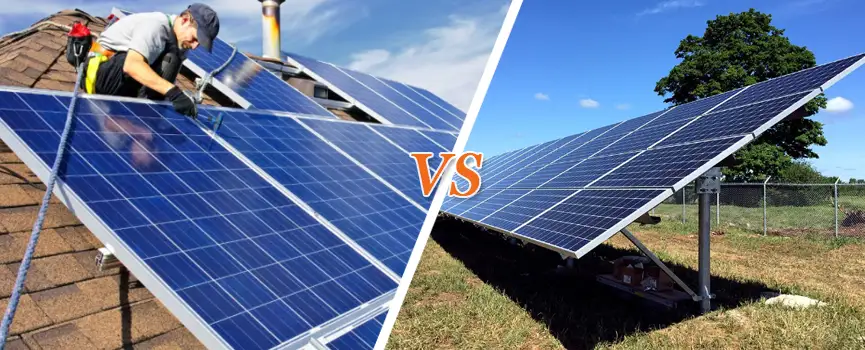
Ground-mounted solar panels require constructing a support structure, which can be as low as a few inches or rise several feet above the ground, unlike the racking system of rooftop solar installations that integrates with an existing building.
Both rooftop and ground-mounted solar setups involve the same electrical connections and safety features. However, a ground-mounted system may need additional wiring due to its placement, which is typically further from your home to prevent shading. Most residential setups use 60-cell solar panels similar to those in rooftop systems, while larger 72-cell panels are preferred for solar farms.
Whether mounted on the roof or the ground, solar panels will generate the same amount of electricity under identical sunlight conditions and wattage. Yet, the advantage of ground-mounted panels lies in their ability to be positioned and angled optimally to capture more sunlight, thus enhancing their efficiency. In contrast, the positioning of rooftop panels depends on the roof’s slope, which can limit their sunlight exposure.
Moreover, a solar tracker can automatically adjust the solar panels to face the sun throughout the day, thereby significantly enhancing the system's energy output. Solar trackers are generally unsuitable for roof installations due to the limitations of standard roof designs.
Ground Mounted Solar System Cost
When considering a solar energy system, it's important to evaluate the installation location and its associated costs. Ground-mounted systems, while offering certain advantages, typically involve additional expenses compared to rooftop installations.
Typically, a ground mount project carries a cost that is about 20 cents per watt higher than that of a rooftop system. A five-kilowatt ground-mounted system will cost approximately $25,000 before deducting any solar incentives and rebates.
Ground-Mounted Bifacial Panels
Bifacial panels are solar PV modules that feature cells on both their front and back sides. In a ground-mounted system, these panels harness power not only from direct sunlight hitting the front but also from sunlight that is reflected or diffused onto the back.
Our research into the energy output of bifacial PV panels revealed that their efficiency hinges on the ground's albedo, or its reflectivity. For example, when installed over grass, the output increase is around 4%, but this jumps to 8% when white pebbles are used beneath the panels.
Plan Your Project
At Mibet, we offer reliable residential and commercial ground-mounted solar installation structures. If you need consultation, assistance with designing your system, or a free quote, please contact us.

